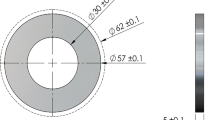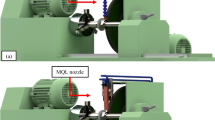Abstract
Advanced ceramics have been extensively used in industry applications due to their properties of high resistance to wear and hardness. However, there is still a high added cost related to the workpiece finish, which is usually performed by the grinding process, the only economically viable process that produces surfaces of high quality and geometric precision. Companies have been looking for optimization in the grinding process, for example in the reduction of the cutting fluid used, in this case also in order to meet the world environmental preservation requirements, without compromising the quality of the finished part. In this context, the present research sought to exploit the technique of minimum quantity of lubrication (MQL) in the external cylindrical plunge grinding of ceramics with diamond grinding wheels. Two methods of cooling-lubrication were used: the conventional and MQL, with three different feed rates (Vf1, Vf2, and Vf3) for each condition. A conventional nozzle and a proper nozzle for MQL with uniform output jet were used. Variables were analyzed as the surface roughness, roundness deviation, scanning electron microscopy (SEM), G ratio, and output acoustic emission. The results showed that the conventional cooling-lubrication gives the best results for the output variables analyzed, comparing with the MQL. However, the MQL still presented satisfactory results that may be sufficient in several cases. Considering the economic, health, and environmental benefits presented by this technique, MQL comes as a strong tendency for ceramic grinding processes.











Similar content being viewed by others
References
Zhang DK, Li C, Jia D, Zhang Y (2014) Investigation into engineering ceramics grinding mechanism and the influential factors of the grinding force. Int J Control Autom 7(4):19–34
Irani RA, Bauer RJ, Warkentin A (2005) A review of cutting fluid application in the grinding process. Int J Mach Tool Manu 45:1696–1705
Agarwal S (2016) Optimizing machining parameters to combine high productivity with high surface integrity in grinding silicon carbide ceramics. Ceram Int 42:6244–6262
Sharma AK, Tiwari AK, Dixit AR (2016) Effects of minimum quantity lubrication (MQL) in machining processes using conventional and nanofluid based cutting fluids: a comprehensive review. J Clean Prod 127:1–18
Ahmed MI, Ismail AF, Nurul AKM (2007) Effectiveness of cryogenic machining with modified tool holder. J Mater Process Technol 185:91–96
Gosaila A (2008). Emerging trends and opportunities for the base oil and lubricant industry. The 5th ICIS Middle Eastern Base Oils & Lubricants Conference, Dubai
Debnath S, Reddy MM, Yi QS (2016) Influence of cutting fluid conditions and cutting parameters on surface roughness and tool wear in turning process using Taguchi method. Measurement 78:111–119
De Groot A, Geier J, Flyvholm M, Lensen G, Coenraads P (2010) Formaldehyde-releasers: relationship to formaldehyde contact allergy. Metalworking fluids and remainder. Part 1. Contact Dermatitis 63:117–128
Suuronen K, Aalto-Korte K, Pipari R, Tuomi T, Jolanki R (2007) Occupational dermatitis and allergic respiratory diseases in Finnish metalworking machinists. Occup Med 57:227–283
Trafny EA (2013) Microorganisms in metalworking fluids: current issues in research and management. Int J Occup Med Environ Health 26:4–15
Emani M, Sadeghi MH, Sarhan AAD, Hasani F (2014) Investigating the minimum quantity lubrication in grinding of Al2O3 engineering ceramic. J Clean Prod 66:632–643
Mamalis AG, Kundrak J, Gyani K, Horvath M (2002) On the precision grinding of advanced ceramics. Int J Adv Manuf Technol 20:255–258
Ramesh K, Yeo SH, Gowri S, Zhoul L (2001) Experimental evaluation of super high-speed grinding of advanced ceramics. Int J Adv Manuf Technol 17:87–92
Marinescu I, Doi TK, Uhlmann E (2015) Handbook of ceramics grinding and polishing. Elsevier, Waltham
Pawar P, Ballav R, Kumar A (2017) Machining processes of silicon carbide: a review. Rev Adv Mater Sci 51:62–76
Malkin S, Hwang TW (1996) Grinding mechanisms for ceramics. CIRP Ann 45(2):569–580
Ajjarapu SK, Fesperman RR, Patten JA, Cherukuri HP (2004) Experimental and numerical investigation of ductile regime machining of silicon nitride. AIP Conference Proceedings 712:1377–1383
Zhong ZW (2003). Ductile or partial ductile mode machining of brittle materials. Int J Adv Manuf Technol 21(8):579–585
Blackley WS, Scattergood RO (1994) Chip topography for ductile-regime machining of germanium. J Eng Ind 116(2):263–266
Malkin S, Ritter JE (1989) Grinding mechanisms and strength degradation for ceramics. J Eng Ind 111:167–174
Marshall DB, Evans AG, Yakub BTK, Tien JW, Kino GS (1983) The nature of machining damage in brittle materials. Proc R Soc Lond A 385:461–475
Emami M, Sadeghii MH, Sarhan AAD, Hasani F (2014) Investigating the minimum quantity of lubrication in grinding of Al2O3 engineering ceramic. J Clean Prod 66:632–643
Bhowmik S, Naik R (2018) Selection of abrasive materials for manufacturing grinding wheels. Materials Today: Proceedings 5(1):2860–2864
Zhang B, Zheng XL, Tokura H, Yoshikawa M (2003) Grinding induced damage in ceramics. J Mater Process Technol 132:353–364
Obikawa T, Kamata Y, Shinozuka J (2006) High-speed grooving with applying MQL. Int J Mach Tool Manu 46:1854–1861
Heisel U, Lutz M, Spath D, Wassmer R, Walter U (1998) A técnica da quantidade mínima de fluidos e sua aplicação nos processos de corte. Revista Máquinas e Metais 385:22–38
Attanasio A, Gelfi M, Giardini C, Remino C (2006) Minimal quantity lubrication in turning: effect on tool wear. Wear 260:333–338
Klocke F, Beck T, Eisenblatter G, Fritsch R, Lung D, Pohls M (2000). Applications of minimal quantity lubrication (MQL) in cutting and grinding. In: Proceeding of the 12th International Colloquium Industrial and Automotive Lubrification, Technische Akademie, Esslingen 11–13.
Marinescu I, Rowe W, Dimitrov B, Inasaki I (2013) Tribology of abrasive machining processes. Elsevier, Waltham
Bianchi EC, Diniz AE, Pereira MG, Neto JFS, Aguiar PR, Guermandi LG (2012) Grinding wheel surface cleaning using a compressed air system, in external plunge grinding of ceramics using the minimum quantity lubricant (MQL) technique. Cerâmica 58:270–274
Bianchi EC, Sato BK, Sales AR, Lopes JC, de Mello HJ, de Angelo Sanchez LE, Aguiar PR (2018) Evaluating the effect of the compressed air wheel cleaning in grinding the AISI 4340 steel with CBN and MQL with water. Int J Adv Manuf Technol 95:5–8
Emani M, Sadeghi MH, Sarhan AAD (2013) Investigating the effects of liquid atomization and delivery parameters of minimum quantity lubrication on the grinding process of Al2O3 engineering ceramics. J Manuf Process 15:374–388
Bianchi EC, Rodriguez RL, Hildebrandt RA, Lopes JC, de Mello HJ, da Silva RB, Aguiar PR (2018) Plunge cylindrical grinding with minimum quantity of lubrication coolant technique assisted with wheel cleaning system. Int J Adv Manuf Technol 95:2907–2916
Bianchi EC, Sato BK, Sales AR, de Lopes JC, Aguiar PR, de Mello HJ, de Sanchez LEA (2018) Influence of water in the MQL technique in the grinding of steel AISI 4340 using CBN wheels. REM - International Engineering Journal 71(3):391–396
Lopes JC, Ventura CEH, de M. Fernandes L et al (2019) Application of a wheel cleaning system during grinding of alumina with minimum quantity lubrication. Int J Adv Manuf Technol 1–9
Acknowledgements
Special thanks to Nikkon Ferramentas de Corte Ltda. for providing the tools and to Jacto for providing the material of the workpieces.
Funding
The authors would like to thank the Sao Paulo Research Foundation (FAPESP) for the financial support (process no. 2015-09868-9). One of the authors thanks the CAPES (Coordination for the Improvement of Higher Level Education Personnel) for the financial support given.
Author information
Authors and Affiliations
Corresponding author
Ethics declarations
Conflict of interest
The authors declare that they have no conflict of interests.
Additional information
Publisher’s note
Springer Nature remains neutral with regard to jurisdictional claims in published maps and institutional affiliations.
Rights and permissions
About this article
Cite this article
Javaroni, R.L., Lopes, J.C., Sato, B.K. et al. Minimum quantity of lubrication (MQL) as an eco-friendly alternative to the cutting fluids in advanced ceramics grinding. Int J Adv Manuf Technol 103, 2809–2819 (2019). https://doi.org/10.1007/s00170-019-03697-z
Received:
Accepted:
Published:
Issue Date:
DOI: https://doi.org/10.1007/s00170-019-03697-z




